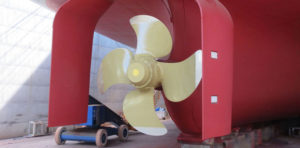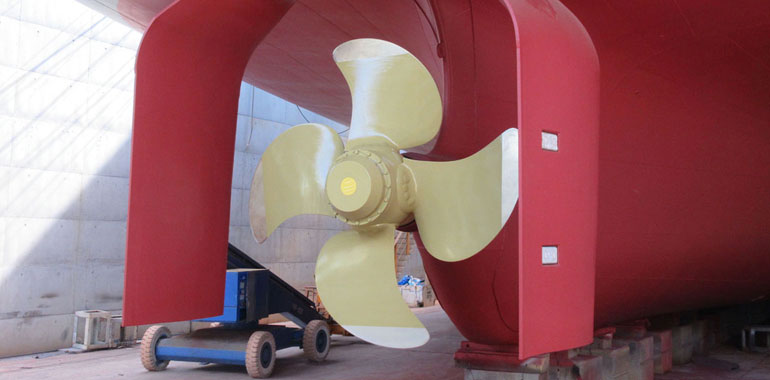
It took a decade or two from the invention of the marine propeller in the 19th century for the technology to become widely accepted. Thereafter, adoption has been nearly universal, but progress toward improved efficiencies has come in fits and starts.
Now, though, a combination of factors — ranging from advances in computer numerical control (CNC) machining and modeling software to plain old ingenuity — have been speeding developments for propellers as well as for their stable mate, the unglamorous rudder.
A particularly interesting innovation in propulsion recently emerged from U.S.-based Sharrow Marine, which offers a new propeller technology that so far has been adopted primarily in the recreational market, but also should find a ready place aboard workboats, ferries and other commercial vessels.
The design was invented by Gregory Sharrow and subsequently developed by Sharrow Engineering LLC in Philadelphia. According to the company, 46 international patents have been filed related to the design, and 24 patents have been awarded in the United States, Japan, Canada, Australia, Europe (14 countries), Taiwan, China and South Korea.
A key claim in the U.S. patent abstract is that the Sharrow propeller has “a means for creating fluid flow in a non-axial direction and redirecting it in an axial direction.” In other words, the centrifugal flow created as a byproduct of creating thrust is largely captured and redirected by employing the Sharrow design, which uses blades that resemble a slightly twisted loop rather than a curved paddle. That unique shape helps explain the company’s claims of improved performance and efficiency.
Reviewers report double-digit improvements in efficiency under many circumstances, along with significantly reduced vibration and fuel consumption. At the 2020 Miami International Boat Show, the Sharrow MX1 earned an innovation award in the Propulsion Equipment & Parts category. One judge hailed it as a “breakthrough prop design that promises lower vibration, increased efficiency and could truly change the industry.”
In the United Kingdom, Oscar Propulsion is exploring an ambitious but somewhat less radical transformation of propellers. It focuses on the problem of cavitation, which reduces efficiency and also creates noise and vibration — bad for vessels and perhaps worse for marine animals. The core of Oscar’s technology has been a discovery that specific arrangements of small holes in blades — even oar blades — can significantly reduce cavitation and noise.
The company claims its PressurePores technology can reduce underwater radiated noise (URN) by between 17 decibels and 21 decibels (85.4 percent to 90.6 percent) in specific frequency ranges.
In addition to these propeller innovations, rudders are also going high tech. As an obvious source of drag, they too have the potential to increase vessel efficiency.
In February, Finland-based Wartsila announced an agreement with the Kuribayashi Steamship Co. of Japan for the development and distribution of an innovative gate rudder that cuts fuel consumption and emissions while also reducing noise and vibration. In addition to Kuribayashi, patent holders include Kamome Propeller; the National Institute of Maritime, Port and Aviation Technology (NIMPAT Japan); Yamanaka Shipbuilding, and Professor Noriyuki Sasaki.
The two main features of the “gate ladder” system are rudders located on either side of a traditional propeller, not behind it, and a rudder structure that partially masks the interference between the propeller and hull by curving over the circumference of the propeller — helping to channel more force toward the stern. Energy savings are reported to be up to 14 percent.
According to the designers, the shape and positioning of the rudders also helps them provide a higher degree of lateral force. Particularly when combined with a bow thruster, this can substantially improve docking maneuverability. The designers even suggest that the system allows for better placement of machinery and greater availability of hull spaces for cargo and other uses.
The development of the system dates back to 2012 when Sadatomo Kuribayashi, chairman of the Kuribayashi Steamship Co., proposed the concept of a “hollow rectangular-type rudder” to Japan’s National Maritime Research Institute. The first trials, with the rudder behind the propeller, were not successful. But later refinements of the shape and location produced positive results.
Wartsila said it is offering gate rudders for new vessels as a way to help achieve compliance with the Energy Efficiency Design Index, which the International Maritime Organization implemented in 2011 for new ships. The technology also can be retrofitted on existing vessels.
While there is wide diversity in these developments, there is a common thread: advances in design processes. The engineering researchers at the Alden Research Laboratory in Holden, Mass., the oldest fluid dynamics research operation in the United States, say the tools have gone beyond the testing tanks, simulations and slide rules that drove designs through the 20th century.
Kimball Hall, principal engineer at Alden, said the focus at the laboratory isn’t on the “bleeding edge,” as it might be at some of the companies developing novel approaches to marine propulsion, but it is highly advanced. What they have in common is powerful open-source simulation and design software such as OpenProp that is empowering designers to create new and custom products like never before.
Hall said OpenProp is widely used not only for the design and analysis of marine propellers, but also for horizontal-axis turbines. He said researchers at Alden use OpenProp and similar tools to find the optimal relationship between motor shaft speed and desired thrust output.
David White, director of gas flow systems engineering at Alden, said the company focuses particularly on the optimization of blades, both for underwater propulsion of vehicles and for underwater power generation. Alden is currently applying the technology to hydrokinetic research with Littoral Power Systems, which received a U.S. Energy Department award to develop very large diameter, low-velocity turbine structures that could potentially harvest the power of the Gulf Stream at a location between Florida and the Bahamas.
But Alden engineer Daniel Bateman stressed that, for all designers, it takes both high-tech and “old school” methods to come up with a solution that actually works in the real world. •

